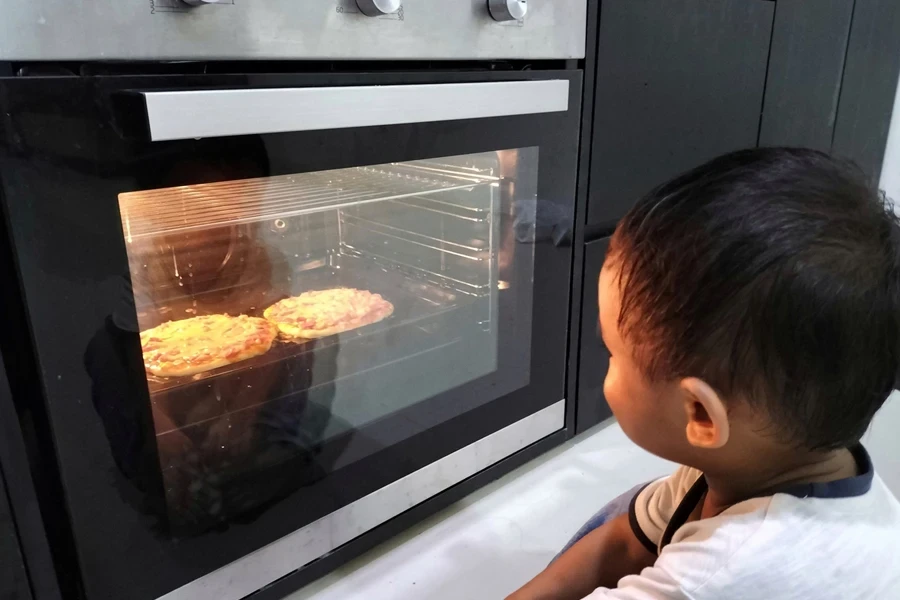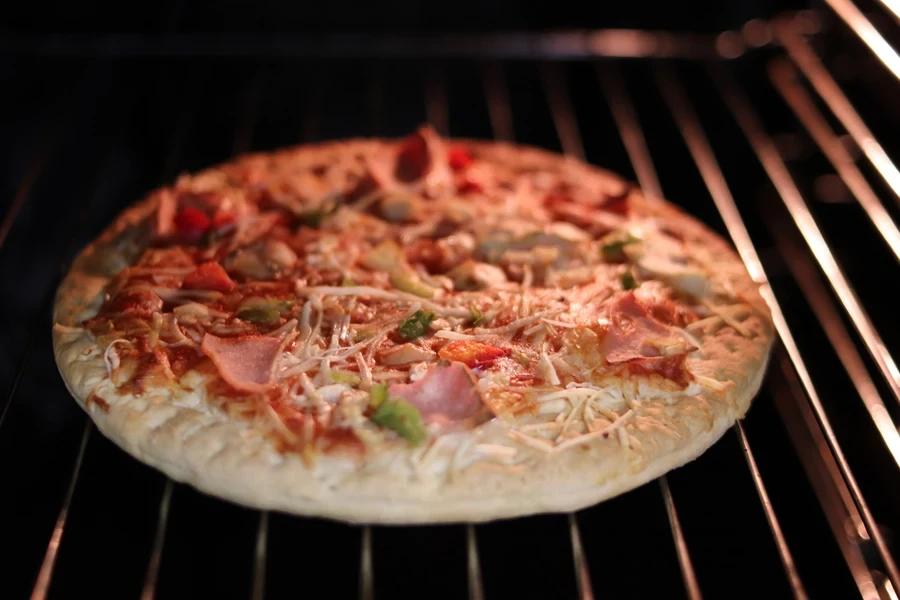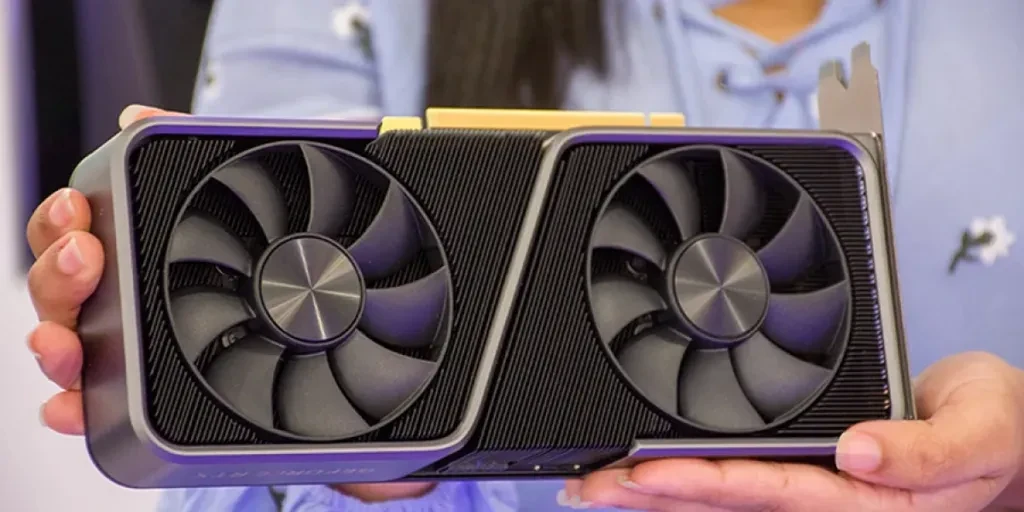Pizza ovens come in many varieties, from rustic wood-fired ones to futuristic electric models that do almost everything but actually slice the pizza, which is why choosing the right models for you can feel overwhelming. Nevertheless, electric pizza ovens make for a great choice if you want something that balances convenience with consistent results.
In this guide, we’ll help you navigate which style is best for your consumers, whether it’s a convection, one with dual-heating elements, stone decks, and more.
Table of Contents
Why consider investing in electric pizza ovens
Types of electric pizza ovens
Countertop ovens
Deck ovens
Conveyor ovens
Portable electric ovens
What to consider when choosing electric pizza ovens to stock
1. Wattage, voltage, and electrical requirements
2. Capacity
3. Construction quality
4. The little extras that make life easier
5. Other uses for electric pizza ovens
Final thoughts
Why consider investing in electric pizza ovens

The world of pizza ovens is vast – wood-fired, gas-fired, coal-fired, you name it. So when does it pay to choose electric? For most consumers, it’s a matter of practicality, pure and simple. Maybe they live in a small apartment or don’t have an outdoor space to build a wood-fired brick oven. Maybe their kitchen doesn’t have a gas line, or they just don’t want to deal with the hassle of tending a live flame.
In these cases, an electric pizza oven may be the best solution. Let’s delve a little deeper into what they offer:
- Consistency: They hold temperature better than a finicky wood fire
- Convenience: Consumers only have to plug it in, set their desired temperature, and go, and won’t need to mess around with logs or a propane tank
- Size options: Businesses can offer a small countertop version or commercial units, depending on their consumers’ needs
Although electric ovens haven’t quite nailed the smoky flavor wood-fire-oven purists love, they have no issue in delivering the perfect crust and gooey cheese. And electric ovens have come a long way in the last decade, with some now being able to hit temperatures well above 500°F, which is more than enough for most pizza styles.
Types of electric pizza ovens

Electric pizza ovens are not a one-type product. Below, we’ll look into four main categories:
Countertop ovens
Countertop pizza ovens are great if you have limited space. They usually fit on a standard kitchen counter and have enough space to handle one 12- or 14-inch pizza at a time. These electric pizza ovens are also perfect for small families or couples.
Deck ovens
Deck ovens often resemble miniature professional pizza ovens (though you can hardly tell the difference with bigger models). They also feature stone or ceramic decks for better heat distribution so the pizza won’t come out undercooked. Additionally, these ovens can have one or multiple decks (up to four tiers), making them the perfect option for serious home pizzaiolas or small businesses.
Conveyor ovens
These electric ovens are more common in chain pizza restaurants. Pizzas slide through a conveyor belt, cooking evenly as they pass the heating elements. While they are fantastic for high-volume operations, they are usually too large for typical home kitchens.
Portable electric ovens
For consumers wanting something lightweight and easy to store away, portable electric ovens will do the trick. Some models can work for indoor and outdoor use (though consumers must have a proper electrical source). Although these models may not reach high temperatures, they’re convenient for occasional pizza nights.
What to consider when choosing electric pizza ovens to stock
1. Wattage, voltage, and electrical requirements

Many consumers buy a new kitchen gadget only to discover they don’t have the right outlet or enough amps to support it. To avoid angry customers bombarding your store with negative reviews, keep an eye on such power requirements and state them clearly on the electric pizza oven’s listings (especially for larger models like deck ovens).
- Standard 120V vs. 240V: Many home kitchens only have 120V outlets, although some have a 240V outlet (common for electric ranges). If consumers can’t accommodate 240V, they’ll be limited to ovens designed for 120V.
- Amperage: Remind consumers to double-check their circuit’s capacity. An oven pulling 15 or 20 amps might trip their breaker if they run it on the same circuit as their dishwasher or microwave.
- Extension cords: Although experts don’t usually recommend extension cords for powerful appliances like pizza ovens, if consumers have to use one, they’ll need a heavy-duty model to handle the load (consider cross-selling this item with your ovens if you have the budget).
2. Capacity
Some consumers think they need the biggest oven they can afford. But if they have a cramped kitchen, they may have storage problems. Businesses therefore consider the following points before they stock:
- Think about how often the target consumers will use it. Are they the type to make one pizza every Friday, or do they host huge Sunday get-togethers with a dozen hungry friends?
- Consider their available space. If the oven will fit in a small kitchen, mention it. Remember to include a wiggle room for proper ventilation and to open the oven door.
- Consider the size of the pizzas they prefer. If consumers like extra-large, 16-inch pies, a small countertop model might be too tight.
3. Construction quality

The perfect electric oven should have a well-insulated chamber with a heavy-duty deck. The deck is important because it helps absorb moisture and distributes heat evenly, helping create that classic crispy-yet-chewy crust. Regardless, consumers may consider these points before picking an electric oven:
- Stone or no stone: If the oven doesn’t have a built-in stone deck (cordierite or ceramic for the best experience), a pizza stone or steel deck can be placed inside, as long as the oven can accommodate it
- Exterior materials: Stainless steel is common and generally easy to clean. Some smaller, cheaper models might have flimsier metal exteriors, which can be fine for light use but not for daily pizza marathons.
- Door design: A sturdy door that opens and closes smoothly is a plus. No one wants something that will warp over time or lose its seal.
4. The little extras that make life easier
Sometimes, the simplest features can change the consumer’s whole cooking experience. Here are a few add-ons or design elements worth considering:
- Timers: This is a great feature for anyone prone to distraction. A built-in timer can easily save users from burnt crust disasters.
- Convection fans: Certain electric ovens include a fan to circulate hot air, promoting even cooking. This can be a bonus if consumers bake other things besides pizza (like bread or cookies), but it’s not a must-have.
- Viewing window: What’s not to love about watching a pizza’s cheese bubble away? A decent light inside the oven helps, too.
- Adjustable thermostats: Depending on a pizza’s dough thickness and crust style, the ability to adjust the heat is a must when it comes to cooking them to perfection
5. Other uses for electric pizza ovens

Yes, it’s called a “pizza oven,” but actually, what’s to stop users from branching out? Pizza ovens can also be a great way to bake bread, roast veggies, and toast sandwiches.
In that sense, their consistent, high heat mimics a professional bakery setup in a pinch, and if the model has a top heating element, they can sometimes double up like a makeshift broiler for crisping up casseroles or melting cheese on nachos.
Final thoughts
Once upon a time not very long ago, many would go out of their way to build wood-fired ovens in their backyard to get that perfect “restaurant-quality” pizza. And while that’s still a wonderful option for consumers who have the space, time, and energy (and an inclination to chop wood), it’s mostly unrealistic for everyone. Luckily, advances in technology now mean that electric pizza ovens hit that sweet spot between practicality and performance, getting hot enough to bake a straightforward, satisfying pie.
To make sure you invest in the right varities for your customers, simply consider the factors discussed above as well as do a little research on the latest models on the market.




